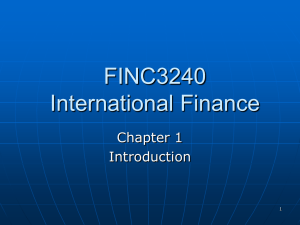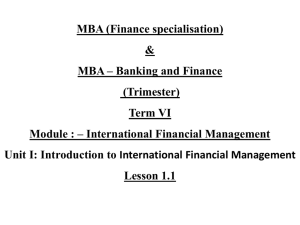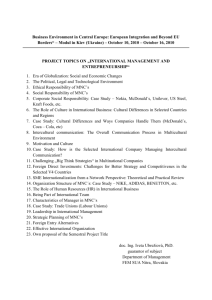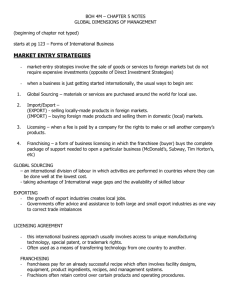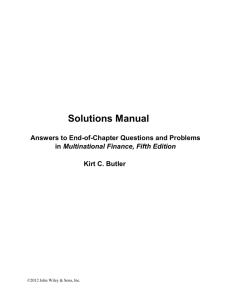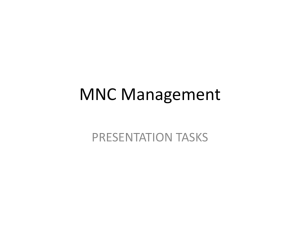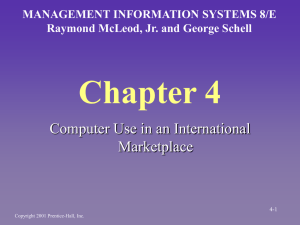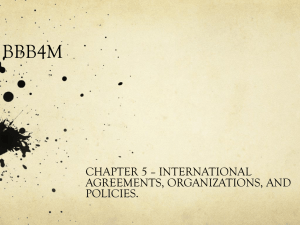Chapter 1
advertisement
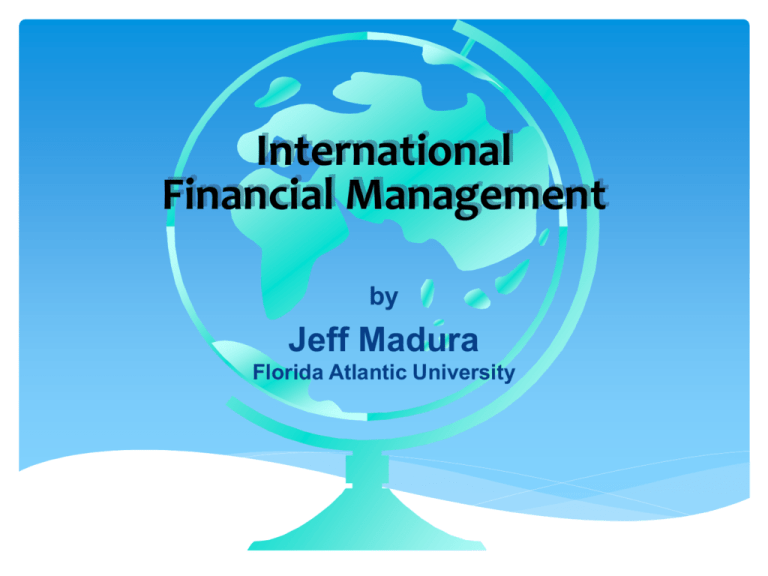
International Financial Management by Jeff Madura Florida Atlantic University Chapter 1 Multinational Financial Management Chapter main Objectives To identify the main goal of the multinational corporation (MNC) and conflicts with that goal; To describe the key theories that justify international business; and To explain the common methods used to conduct international business. Introduction to International Financial Management Email/ F.B : nusrat2008noori@yahoo.com What is IFM?? International Financial Management is also known as International Finance or international macroeconomics. It is a popular concept which means management of finance in an international business environment. it implies, doing of trade and making money through the exchange of foreign currency. The International Financial activities help the organizations to connect with international dealings with overseas business partners- customers, suppliers, lenders etc. It is also used by Government organization and Non-profit institutions Conti….. The management of finance internationally occurs in international financial environment. An international financial environment represents the conditions for activity in the economy or in the financial markets around the world. Governments, corporations, and other investors around the world participate in purchasing the debt of other nations as profit opportunities arise. Or they may simply invest their funds and expand their business in other county. The International Financial Environment Multinational Corporation (MNC) Foreign Exchange Markets Exporting & Importing Product Markets Dividend Remittance & Financing Subsidiaries Investing & Financing International Financial Markets The International Financial Environment 1. A multinational corporation (MNC) or multinational enterprise (MNE) or international corporation is a corporation that is registered in more than one country or that has operations in more than one country. It is a large corporation which both produces and sells goods or services in various countries. They play an important role in globalization. 2. FEM is a Market in which foreign currencies are bought and sold and exchange rates between currencies are determined. It is constructed of a global network of computers that connects participants from all parts of the world. The International Financial Environment The main participants in this market are the larger international banks. 3. Remittance is the process of sending money to remove an obligation. This is most often done through an electronic network, wire transfer or mail. The term also refers to the amount of money being sent to remove the obligation. Financing means finding funds for corporations from investors. Multinational Corporations Email/ F.B : nusrat2008noori@yahoo.com What is a corporation and MNC?? A corporation is a legal entity that is designed to protect its individual members from financial liability and is engaged in business activities within a country. A corporation that has its facilities and other assets in at least one country other than its home country is called MNC. Such companies have offices and/or factories in different countries and usually have a centralized head office where they co-ordinate global management. Types of MNCs There are four categories of multinational corporations: (1) a multinational, decentralized corporation with strong home country presence, (2) a global, centralized corporation that acquires cost advantage through centralized production whether cheaper are available, Parent Company: Domestic branch is called main or parent company. Subsidiaries Company: In other countries branches is called subsidiaries company. Centralized Multinational Financial Management for an MNC with two subsidiaries, A and B Cash Management at A Inventory and Accounts Receivable Management at A Financing at A Capital Expenditures at A Financial Managers of Parent Cash Management at B Inventory and Accounts Receivable Management at B Financing at B Capital Expenditures at B Decentralized Multinational Financial Management for an MNC with two subsidiaries, A and B Cash Management at A Financial Managers of A Inventory and Accounts Receivable Management at A Financing at A Capital Expenditures at A Financial Managers of B Cash Management at B Inventory and Accounts Receivable Management at B Financing at B Capital Expenditures at B The main Goal of the MNC Corporations whether national or international are owned by shareholders, and their purpose is to maximize profits for their owners. The commonly accepted goal of an MNC is to maximize shareholder wealth. Suppose a stock holder buys a stock at $10 and in ten years time the market price of stock shoots up to $55. There are two way to maximize the wealth: 1. Capital Gain 2. Dividend Increase Another objective may be to provide employment to the citizens of another country. The MNCs’ evolution It is the fact that non of the countries all over the world are self sufficient. They lack some resources which are the need of it. They may find those resources in other country. So this fact gives birth to MNCs. Multinational firms arise because capital is much more mobile than labor. Since cheap labor and raw material inputs are located in other countries, multinational firms establish subsidiaries there to fulfill their need. They may also arise as the result of export by a domestic company or by foreign direct investment. Conflicts Against the MNC’s Goal The MNCs while trying to achieve Its main goal ( maximization of share holders wealth ) may face the following conflicts. 1. Agencies problems 2. Management problems 3. shareholders problems What is agency Problem?? The agency problem reflects a conflict of interests between decision-making managers and the owners of the MNC. The agency problem is that the agent who is supposed to make the decisions that would best serve the principal is naturally motivated by self-interest, and the agent's own best interests may differ from the principal's best interests. For example: A decision to expand a subsidiary may be motivated by a manager's desire to receive more compensation rather than to enhance potential benefits to shareholders. This conflict of goals between a firm's managers and shareholders is often known as the agency problem. Agency costs occur in an effort to assure that managers act in the best interest of the owners. Conflicts Against the MNC’s Goal Agency costs are normally larger for MNCs than for purely domestic firms because: a) monitoring more difficult because of geographic distance b) different cultures c) MNC size d) subsidiary managers may maximize the value of their subsidiary but not of the MNC as a whole The parent corporation of an MNC may be able to prevent agency problems with proper governance. It should clearly communicate the goals for each subsidiary to ensure that all subsidiaries focus on maximizing the value of the MNC rather than their respective subsidiary values. Conflicts Against the MNC’s Goal 2. Management : Management of MNCs ( centralized and decentralized) can also have an impact against its goal. The magnitude of conflict can vary with the management style of the MNC. A centralized management style may reduces conflict. However, a decentralized style gives more control to those managers who are closer to the subsidiary’s operations and environment so it may increase the conflict to achieve MNCs goals. Centralized management reduces agency costs because it gives parent more control but a local managers may better perform. decentralized management increases agency costs but may result in better decisions Conflicts Against the MNC’s Goal 3. shareholders problems: They may also create a conflict for MNCs to meet their goal. By shareholders problems we mean 1. threat of hostile takeover مخالف بغاوت کا خطرہ تهدید از تصاحب خصمانه 2. monitoring by large shareholders بڑی حصص یافتگان کے ذریعے نگرانی نظارت سهامداران بزرگ Solution to conflicts against MNC goals Following are some steps which may help reduce conflicts. Establishing a centralized database of information Ensuring that all data are reported consistently among subsidiaries Implementing a system that automatically checks data for unusual discrepancies relative to norms Speeding the process by which all departments and all subsidiaries have access to the data that they need Making executives more accountable for financial statements by personally verifying their accuracy Constraints Interfering with the MNC’s Goal As MNC managers attempt to maximize their firm’s value, they may be confronted with various constraints. Following are the most common one; 1. Environmental constraints. e.g. other countries may be tougher in pollution etc… 2. Regulatory constraints. e.g. currency convertibility, remittance of profits, etc. 3. Ethical constraints. e.g. bribes may be more acceptable in other countries Theories of International Business Email/ F.B : nusrat2008noori@yahoo.com Why firms are motivated to expand their business internationally??? OR WHY FIRMS PURSUE INTERNATIONAL BUSINESS??? Answer to these technical questions can be given by discussing the theories of International Business. Which are; 1. The comparative advantage theory 2. The imperfect markets theory 3. The product cycle theory 1. The theory of Comparative Advantage The ability of a firm or individual to produce a particular good or service at a lower cost than other firms or individuals. (C.A) This theory states that specialization by countries can increase production efficiency. Some countries, such as Japan and the United States, have a technology advantage, while other countries, such as Jamaica, China, and Malaysia, have an advantage in the cost of basic labor. These countries tend to use their advantages to specialize in the production of goods that can be produced with relative efficiency. When a country specializes in some products, it may not produce other products, so trade between countries is essential. This is the argument made by the classical theory of comparative advantage. 2. The Imperfect Markets Theory A market where information is not quickly disclosed to all participants in it and where the matching of buyers and sellers isn't immediate. This theory states that The markets for the various resources used in production are “imperfect.” so one can get the benefit of factor of production if markets were perfect so that the factors of production (such as labor) were easily transferable, then labor and other resources would flow wherever they were in demand. However, the real world suffers from imperfect market conditions . MNCs such as the Gap and Nike often capitalize on a foreign country's resources. Imperfect markets provide an incentive for firms to seek out foreign opportunities. 3. The Product Cycle Theory According to this theory, firms become established in the home market as a result of some perceived advantage over existing competitors. Because information about markets and competition is more readily available at home, a firm is likely to establish itself first in its home country. Foreign demand for the firm's product will initially be accommodated by exporting. As time passes, the firm may feel the only way to retain its advantage over competition in foreign countries and produce the product in foreign markets to reduce transportation costs. The firm may develop strategies to prolong the foreign demand for its product. A common approach is to attempt to differentiate the product from its foreign competitors. The International Product Life Cycle Firm creates product to accommodate local demand. a. Firm differentiates product from competitors and/or expands product line in foreign country. Firm exports product to accommodate foreign demand. or b. Firm’s foreign business declines as its competitive advantages are eliminated. Firm establishes foreign subsidiary to establish presence in foreign country and possibly to reduce costs. International Business Methods Email/ F.B : nusrat2008noori@yahoo.com International Business Methods How FIRMS ENGAGE IN INTERNATIONAL BUSINESS???? There are several methods by which firms can conduct international business. Following are the most common methods used globally; 1. International trade 2. Licensing 3. Franchising 4. Joint venture 5. Acquisitions of existing operations 6. Establishing New Foreign Subsidiaries. 7. Direct Foreign Investment (DFI). International Business Methods 1. International trade is a relatively conservative approach involving exporting and/or importing. The internet facilitates international trade by enabling firms to advertise and manage orders through their websites. 2. Licensing allows a firm to provide its technology in exchange for fees or some other benefits. 3. Franchising obligates a firm to provide a specialized sales or service strategy, support assistance, and possibly an initial investment in the franchise in exchange for periodic fees. International Business Methods 4. Firms may also penetrate foreign markets by engaging in a joint venture (joint ownership and operation) with firms that reside in those markets. 5. Acquisitions of existing operations in foreign countries allow firms to quickly gain control over foreign operations as well as a share of the foreign market. 6. Firms can also penetrate foreign markets by establishing new foreign subsidiaries. 7. In general, any method of conducting business that requires a direct investment in foreign operations is referred to as a direct foreign investment (DFI). International Opportunities Investment opportunities - The marginal return on projects for an MNC is above that of a purely domestic firm because of the expanded opportunity set of possible projects from which to select. Financing opportunities - An MNC is also able to obtain capital funding at a lower cost due to its larger opportunity set of funding sources around the world. Chapter Review Goal of the MNC Conflicts Against the MNC Goal Impact of Management Control Impact of Corporate Control Constraints Interfering with the MNC’s Goal Theories of International Business Theory of Comparative Advantage Imperfect Markets Theory Product Cycle Theory Chapter Review International Business Methods International Trade Licensing Franchising Joint Ventures Acquisitions of Existing Operations Establishing New Foreign Subsidiaries
